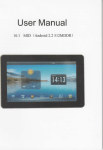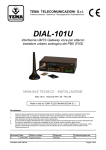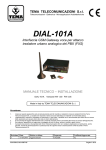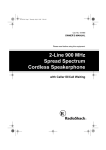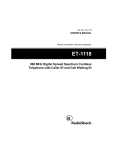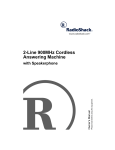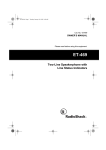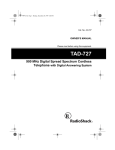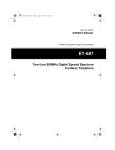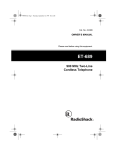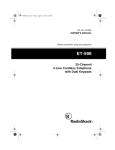Download Radio Shack ET-686 Owner`s manual
Transcript
43-686.fm Page 1 Friday, September 10, 1999 3:13 PM Cat. No. 43-686 OWNER’S MANUAL Please read before using this equipment. 2-Line 900 MHz Cordless Speakerphone ET-686 43-686.fm Page 2 Friday, September 10, 1999 3:13 PM FEATURES Your RadioShack ET-686 2-Line 900MHz Cordless Speakerphone uses advanced cordless telephone technology to give you superior audio quality and extended range. The ET-686 lets you make and receive calls on two separate telephone lines. Its features include: Paging/Two-Way Intercom System — lets you send a signal from the base to the handset, or from the handset to the base, to page someone or locate the handset when it is away from the base. If someone answers, you can use the ET- 686 as an intercom. 900 MHz Operation — provides longer range and less interference than many other cordless phones. Volume Controls – let you adjust the volume you hear through the handset and speakerphone. Two-Line Telephone System — lets you easily handle two telephone lines at the same time. You can use both lines to make 3- or 4-way conference calls, or one line for data communication while you are talking on the other. Adjustable Ringer — lets you choose high or low volume for each line’s ringer on the handset, or turn the base’s ringer off. Dual Keypads — a full set of keys on both the ET-686’s handset and base let you use either keypad to make and answer calls or use the phone’s features. Speakerphone — lets you make or answer calls without using the handset. Ample Talk and Standby Time — the supplied battery pack provides 7 hours of continuous talk time or 7 days of standby time (when fully charged). 20-Number Memory Dialing — lets you store up to 20 numbers in memory (10 each in the handset and base) for easy dialing. Wall Mountable — you can mount the ET-686 on the wall to save space on your desk top. Headset Jack — lets you make or answer calls with hands-free convenience using an optional headset. Facedown or Faceup Handset Charging — you can place the handset on the base facedown or faceup. 40 Channels — automatically selects a clear channel when you make or answer a call. Security Access-Protection Code — automatically prevents other cordless phone users from using your phone line while the handset is off the base. © 1999 Tandy Corporation. All Rights Reserved. RadioShack is a registered trademark used by Tandy Corporation. 2 43-686.fm Page 3 Friday, September 10, 1999 3:13 PM Line Status Indicators — show if a line is available, in use, or on hold. Auto Talk — lets you set the ET-686 so you can answer a call by lifting the handset from the base. Any Key Answer — lets you set the ET686 so you can press any key to answer a call on the base or on the handset when it is away from the base. Redial — lets you quickly redial the last number dialed. Flash — sends an electronic switchhook signal for use with special phone services, such as Call Waiting. We recommend you record your phone’s serial number here. The number is on the bottom of the base. Serial Number: ___________________ WARNING: To reduce the risk of fire or shock hazard, do not expose this product to rain or moisture. CAUTION RISK OF ELECTRIC SHOCK. DO NOT OPEN. CAUTION: TO REDUCE THE RISK OF ELECTRIC SHOCK, DO NOT REMOVE COVER OR BACK. NO USER-SERVICEABLE PARTS INSIDE. REFER SERVICING TO QUALIFIED PERSONNEL. This symbol is intended to alert you to the presence of uninsulated dangerous voltage within the product’s enclosure that might be of sufficient magnitude to constitute a risk of electric shock. Do not open the product’s case. Tone/Pulse Dialing — lets you use your phone with either type of service, and you can easily switch from pulse to tone dialing for long-distance, bank-byphone, or other special services. Hearing-Aid Compatibility — lets you use your phone with hearing aids that have a T (telephone) switch. This telephone has been tested and found to comply with all applicable UL and FCC standards. ! ! This symbol is intended to inform you that important operating and maintenance instructions are included in the literature accompanying this product. 3 43-686.fm Page 4 Friday, September 10, 1999 3:13 PM Important: • Cordless phones such as this one require AC power to operate. When the AC power is off, you cannot dial out or receive incoming calls using your ET-686. To be safe, you should also have a phone that does not need AC power to operate (not a cordless phone) so you can still make and receive calls if there is an AC power failure. • When AC power is lost, the ET-686 loses the security access-protection code connection between the base and the handset. When power is restored, put the handset on the base briefly to restore this connection so you can use the handset. READ THIS BEFORE INSTALLATION We have designed your phone to conform to federal regulations and you can connect it to most phone lines. However, each device that you connect to the telephone line draws power from the line. We refer to this power draw as the phone's ringer equivalence number, or REN. The REN is on the bottom of your phone. If you use more than one phone or other device on the line, add up all the RENs. If the total is more than five (three in rural areas), your phones might not ring. If ringer operation is impaired, remove one of the devices from the line. 4 FCC STATEMENT Your telephone complies with Part 68 of FCC Rules. You must, upon request, provide the FCC registration number and the REN to your phone company. These numbers are on the bottom of the base. You must not connect your phone to any of the following: • coin-operated systems • party-line systems • most electronic key phone systems This equipment complies with the limits for a Class B digital device as specified in Part 15 of FCC Rules. These limits provide reasonable protection against radio and TV interference in a residential area. However, your equipment might cause TV or radio interference even when it is operating properly. To eliminate interference, you can try one or more of the following corrective measures. • Reorient or relocate the receiving antenna. • Increase the distance between the equipment and the radio or TV. • Use outlets on different electrical circuits for the equipment and the radio or TV. Consult your local RadioShack store if the problem still exists. 43-686.fm Page 5 Friday, September 10, 1999 3:13 PM CONTENTS Installation ............................................................................................................... 6 Mounting the Phone ........................................................................................... 6 Connecting to the Phone Lines .................................................................... 6 On a Desk Top ............................................................................................. 6 On a Wall or Wall Plate ................................................................................ 7 Connecting and Charging the Battery Pack ..................................................... 10 Setting the Dialing Mode .................................................................................. 11 Adjusting the Ringer ......................................................................................... 12 On the Handset .......................................................................................... 12 On the Base ............................................................................................... 12 Operation ............................................................................................................... 13 Using the Handset ............................................................................................ 13 Making a Call ............................................................................................. 13 Answering a Call ........................................................................................ 13 Setting the Handset Volume ...................................................................... 13 Changing the Channel ............................................................................... 13 Using the Speakerphone .................................................................................. 14 Making a Call ............................................................................................. 14 Answering a Call ........................................................................................ 14 Adjusting the Speakerphone Volume ......................................................... 14 Using Mute ................................................................................................. 15 Using Hold ........................................................................................................ 15 Switching Between the Handset and Speakerphone ....................................... 15 Using Both the Handset and Speakerphone .................................................... 16 Making a Conference Call ................................................................................ 16 3-Way Conferencing .................................................................................. 16 4-Way Conferencing .................................................................................. 16 Using the ET-686 with Extension Phones ........................................................ 17 Using Redial ..................................................................................................... 17 Using Flash ...................................................................................................... 18 Using Tone Services on a Pulse Line ............................................................... 18 Using the Paging/Intercom Features ................................................................ 18 Memory Dialing ................................................................................................ 19 Storing a Number in Memory ..................................................................... 19 Entering a Pause ....................................................................................... 20 Dialing a Memory Number ......................................................................... 20 Chain-Dialing Service Numbers ................................................................. 20 Testing Stored Emergency Numbers ......................................................... 20 Using a Headset ............................................................................................... 21 Troubleshooting .................................................................................................... 22 Care and Maintenance .......................................................................................... 24 5 43-686.fm Page 6 Friday, September 10, 1999 3:13 PM INSTALLATION MOUNTING THE PHONE You can place the ET–686’s base on a desk or table, or mount it on a standard wall plate or directly on a wall. Choose a location that is: • near an accessible AC outlet • near a modular telephone line jack • out of the way of normal activities • away from electrical machinery, electrical appliances, metal walls or filing cabinets, wireless intercoms, alarms, and room monitors • away from other cordless phones The base’s location affects the handset’s range. If you have a choice of several locations, try each to see which provides the best performance. Connecting to the Phone Lines To take full advantage of the ET-686’s capabilities, you must have two phone lines with separate phone numbers. If you have only one line, you can order a second from your phone company. You can connect the ET-686 to the lines in one of these ways: • connect two lines through a two-line modular phone jack • connect two lines through two oneline modular phone jacks • connect one line through a one-line modular phone jack 6 Notes: • Your phone connects directly to a modular phone line jack. If your phone wiring does not have a modular jack, you can update it using jacks and adapters available at your local RadioShack store. Or, you can have the phone company update it for you. • The line that connects a two-line phone jack to the phone company wiring must be twisted-pair cable. Otherwise, you might hear interference (crosstalk) between the two lines. • The USOC number of the two-line jack to be installed is RJ14C (RJ14W for a wall-plate). The USOC number of a single-line jack is RJ11C. Caution: The supplied RadioShack adapter was designed specifically for your ET-686. Use only the supplied adapter. On a Desk Top 1. To connect the phone to a two-line phone jack, plug one end of the supplied long two-line modular cord into the TEL LINE 1/2 jack on the back of the phone. 43-686.fm Page 7 Friday, September 10, 1999 3:13 PM Note: If you connect the phone to a two-line phone jack with a two-line cord, do not connect a cord to the TEL LINE 2 jack or the phone will not operate properly. Instead, you can connect another phone device, such as a fax machine or modem. 3. Route the adapter’s cord through the strain relief slot on the bottom of the bracket. 4. Plug the adapter into a standard AC outlet. 5. Connect the phone cord(s) to the modular phone line jack(s). To connect the phone to two oneline phone jacks, plug one end of the supplied long two-line modular cord into TEL LINE 1/2 and plug another cord (not supplied) into the TEL LINE 2 jack. To connect the phone to a single one-line phone jack, plug one end of the supplied long modular cord into the TEL LINE 1/2 or TEL LINE 2 jack. Note: If you connect the phone to a single one-line phone jack, do not press the unused line button or you might hear feedback. 6. Raise the base’s antenna to a vertical position. On a Wall or Wall Plate Note: To mount the base directly on the wall, you need two screws (not supplied) with heads that fit into the keyhole slots on the bottom of the bracket. Drill two holes 315/16 inches apart. Then thread a screw into each hole, letting the heads extend about 5/16 inch from the wall. 2. Plug the supplied AC adapter’s barrel plug into the DC IN 9V jack on the back of the base. 7 43-686.fm Page 8 Friday, September 10, 1999 3:13 PM 1. Insert the two tabs at the top of the narrow end of the supplied bracket into the base’s upper tab slots as shown, then press down on the bracket’s latches and insert them into the clip slots. To connect the phone to two oneline phone jacks, plug one end of the supplied short two-line modular cord into TEL LINE 1/2 and plug another cord (not supplied) into the TEL LINE 2 jack. 2. To connect the phone to a two-line phone jack, plug one end of the supplied long modular cord into the TEL LINE 1/2 jack on the back of the phone. To connect the phone to a single one-line phone jack, plug one end of the supplied long modular cord into the TEL LINE 1/2 or TEL LINE 2 jack. Note: If you connect the phone to a single one-line phone jack, do not press the unused line button or you might hear feedback. 3. Insert the supplied AC adapter’s barrel plug into the DC IN 9V jack on the back of the base. Note: If you connect the phone to a two-line phone jack with a two-line cord, do not connect another (third) phone line to the TEL LINE 2 jack or the phone will not operate properly. Instead, you can connect another phone device such as a fax machine or modem. 8 43-686.fm Page 9 Friday, September 10, 1999 3:13 PM 4. Route the adapter’s cord through the narrow groove on the bracket. If you are using two phone cords, route the second cord through one of the wide grooves on the bracket. 5. To mount the phone on a wall plate, plug the other end of the short modular cord into the wall plate jack, then align the bracket’s keyhole slots with the wall plate studs and slide the base downward to secure it. If you are using two phone cords, plug the second cord into the second phone jack. To mount the phone directly on a wall, align the bracket’s keyhole slots with the mounted screws and slide the base downward to secure it. Connect the phone cord(s) to the modular phone line jack(s). 6. Plug the adapter into a standard AC outlet. 9 43-686.fm Page 10 Friday, September 10, 1999 3:13 PM 7. Press and lift out the handset holder, flip it over as shown, then snap it back into place. 2. Plug the battery pack’s connector into the socket in the compartment. The connector fits only one way. 8. Raise the base’s antenna to a vertical position. 3. Replace the battery pack and the cover. CONNECTING AND CHARGING THE BATTERY PACK The ET-686 comes with a rechargeable nickel-cadmium battery pack in the handset but not connected. Before using your phone, you must connect the battery pack, then charge it for about 24 hours. Recharge the battery pack when the handset beeps every 3 seconds or its line indicators flash every 3 seconds. To charge the battery pack, place the handset either faceup or facedown on the base. The CHARGE indicator on the base lights. 1. Slide open the battery compartment cover and lift the battery pack out of the compartment. Important: Be sure the battery pack is properly connected before you try to charge it. The CHARGE indicator lights whenever the handset is on the base, even if the battery pack is not connected. 10 43-686.fm Page 11 Friday, September 10, 1999 3:13 PM Notes: • When you first use the phone after charging or recharging the battery pack, the phone might not work and you might hear an error tone when you press LINE 1 or LINE 2. If this happens, return the handset to the base for about five seconds. This resets the security access-protection code. • If the battery pack gets weak during a call, the handset beeps every 3 seconds and the line indicators flash. When this happens, you cannot make another call on the phone until you recharge the battery pack. • Use a pencil eraser to clean the charging contacts on the handset and the base about once a month. • About once a month, fully discharge the battery pack by keeping the handset off the base until the low battery indications (flashing line indicators and beeping) appear. Otherwise, the battery pack loses its ability to fully recharge. • The supplied battery pack should last for about a year. When the battery pack loses its ability to fully recharge, order a replacement battery pack at your local RadioShack store (see “Replacing the Battery Pack” on Page 25). SETTING THE DIALING MODE Set PULSE-TONE on the back of the base for the type of service you have. If you are not sure which type you have, do this test. 1. Be sure PULSE-TONE is set to TONE. PULSE-TONE • If the battery pack becomes completely discharged or the base loses power while the handset is away from it, the security code might be lost. To reset the code, return the handset to the base. If it was the handset that lost power, leave the handset on the base to charge the battery pack. 11 43-686.fm Page 12 Friday, September 10, 1999 3:13 PM 2. Press LINE 1 on the base. The LINE 1 SPEAKER indicator lights. Then listen for the dial tone. LINE 1 LINE 2 can choose from a high or low ringer setting for the base and the handset. On the Handset At any time except during a call, press VOLUME to set the handset’s ringer volume. The phone rings at the selected volume. 3. Press any number other than 0 on the base keypad. Note: If your phone system requires that you dial an access code (9, for example) before you dial an outside number, do not press the access code either. If the dial tone stops, that line has tone service. If the dial tone continues, that line has pulse service. 4. Press LINE 2, listen for the dial tone, and repeat Step 3. If you have tone service on both lines, leave PULSE-TONE set to TONE. If you have pulse service on either line, set PULSE-TONE to PULSE. ADJUSTING THE RINGER The ET-686 lets you control its base and handset ringer volume separately. You 12 VOLUME On the Base Set RING VOL for each line (L1 or L2) on the back of the base to HI, LO, or OFF. With RING VOL set to OFF, the base’s ringer does not sound when a call is received, but the handset still rings when it is off the base (as does any other phone connected to the same line). The handset does not ring when it is on the base. RING VOL 43-686.fm Page 13 Friday, September 10, 1999 3:13 PM OPERATION Note: You can use the keypad on either the handset or the base to operate the ET-686. To make a call with the speakerphone, you must use the base’s keypad; to make a call with the handset, you must use the handset’s keypad. USING THE HANDSET Making a Call To make a call using the handset, lift the handset from the base and press LINE 1 or LINE 2, then dial the number. When you press a line button on the handset, that line’s indicator on the handset lights. The same line’s indicator on the base flashes to show that someone is using that line at the handset. Note: If a line indicator on the handset is flashing, someone is using that line at the base. Press the other line button. To end a call, press LINE 1 or LINE 2 on the handset or place the handset on the base. Answering a Call that is ringing, or press any key to answer a call. The indicator for the line you are using lights at the handset and flashes at the base. If you receive a call on one line while you are using the handset to talk on the other, you hear three ring tones through the handset. Press the line button for the incoming call’s line. The current call is automatically placed on hold. If both lines have an incoming call, pressing a key answers the line that received a call first. Setting the Handset Volume To increase or decrease the handset’s volume during a call, press VOLUME. Each time you press the button, the volume setting changes to low, medium, high, or loud. Changing the Channel If you hear interference, static, or noise during a call, you can press CH to find a clearer channel. When a call comes in, the line indicator for that line flashes at the handset and base. Note: To help you tell which line is ringing, each line has a distinctive ring tone. CH To answer a call, lift the handset from the base. If the handset is away from the base, press the line button for the line 13 43-686.fm Page 14 Friday, September 10, 1999 3:13 PM The ET-686 changes to a different channel each time you press CH. lights at the base and flashes at the handset. Note: If the handset is too far from the base, the channel might not change and the phone sounds the error beeps. Move closer to the base and try again. If you receive an incoming call on a line while you are talking on the speakerphone on the other, the new call’s line indicator flashes and you hear a low ring if you have set the RINGER VOL to HI or LO. Press the line button for the incoming call. The current call is automatically placed on hold. USING THE SPEAKERPHONE Making a Call To make a call using the speakerphone, press LINE 1 (or LINE 2), listen for the dial tone, then dial the number. When you press a line button on the base, that line’s SPEAKER indicator on the base lights. The same line’s indicator on the handset flashes to show that someone is using that line at the base. Note: If either SPEAKER indicator on the base is flashing, someone at the handset is using the line. Press the other line button. If both lines have an incoming call, pressing a number key answers the line that received a call first, unless only one line has its ringer on. In that case, pressing a number key answers the line with its ringer on. Adjusting the Speakerphone Volume To set the speakerphone’s volume, slide VOLUME on the right side of the base. To end a speakerphone call, press LINE 1 (or LINE 2) again. Answering a Call When a call comes in, the indicator for that line flashes at the handset and base. To answer a call, press the line button for the line that is ringing, or press any number key. The indicator for that line 14 VOLUME 43-686.fm Page 15 Friday, September 10, 1999 3:13 PM Using Mute While talking on the speakerphone, you can temporarily turn off the ET-686’s microphone by pressing MUTE so the other party cannot hear you. The SPEAKER indicator flashes red when a line is muted. Press MUTE again to resume your conversation. MUTE Note: If you are using a line on the handset only, pressing HOLD on the base will not place the call on hold and vice versa. While a call is on hold, you can temporarily place the handset on the base or use the other phone line without disconnecting the current call. To release a line from hold, press that line’s button on the handset or base, or pick up an extension phone. You can also release a call from hold by lifting the handset if the handset is on the base. Pressing HOLD again while a call is on hold does not release the hold. Note: Mute is released when you press INTERCOM or HOLD, or you press either line button to switch the line. USING HOLD Note: If you put both lines on hold, lifting the handset might not release the call. If this happens, press the line button to release that line. SWITCHING BETWEEN THE HANDSET AND SPEAKERPHONE To switch to the speakerphone while you are using the handset, press HOLD on the handset, then press that line’s button (LINE 1 or LINE 2) on the base. HOLD Press HOLD on the handset or base (where a line is in use) to place a call on hold. The indicator for that line flashes on the handset and lights red on the base. To switch to the handset while you are using the speakerphone, lift the handset off the base. Or, if the handset is off the base, press HOLD on the base, then press that line’s button (LINE 1 or LINE 2) on the handset. 15 43-686.fm Page 16 Friday, September 10, 1999 3:13 PM USING BOTH THE HANDSET AND SPEAKERPHONE To use the handset to join a call at the base, or to use the base to join a conversation at the handset, press the line button for the line that is in use. You hear a busy tone. Before the tone ends, press the line button again. During the call, one of you can hang up and the call can continue. To end the call, you must hang up both the base and handset. Note: If you hear a high-pitched noise from the base’s speaker, the handset and the base are too close together. To talk with two parties using both lines, see “4-Way Conferencing.” MAKING A CONFERENCE CALL 3-Way Conferencing Follow these steps to use both phone lines to set up a 3-way call. The procedure is the same for the handset and the base. 1. Place the first call on hold. 2. Make or answer a call on the other line. 16 3. Once you have the second party on the line, press CONF to bring in the first party. Both line indicators light steadily. You can now talk with both parties, and they can talk with each other. CONF 4. To end the conference call, press one line button, then the other. If you want to hang up one line and continue talking on the other, press the line button you want to hang up. If you want to talk on one line without disconnecting the other, press HOLD, then the button for the line you want to talk on. To return to a 3way conversation, press CONF. 4-Way Conferencing Follow these steps to use both lines and the ET-686’s intercom function to set up a four-way call (see “Using the Paging/ Intercom Features” on Page 18). 1. Make a 3-way conference call. (See “3-Way Conferencing.”) 43-686.fm Page 17 Friday, September 10, 1999 3:13 PM 2. Press INTCM on the handset or INTERCOM on the base to page the other keypad. INTERCOM To join the conversation from the handset or base, press the line button for the line in use. You hear a busy tone: before the tone ends, press the line button again. Note: If you hang up the ET-686 and someone is still on that line on an extension, the ET-686’s line indicator(s) might not stay lit. INTCM The two outside lines are automatically placed on hold, but the parties on both lines can talk with each other. 3. To answer the page, press INTCM on the handset, or INTERCOM on the base, then press CONF. USING REDIAL You can quickly dial the last number dialed on either line 1 or line 2. When you hear a dial tone, press REDIAL/PAUSE on the base or REDIAL on the handset. REDIAL/PAUSE 4. To end the conference call, press LINE 1 and LINE 2 on one keypad, then press LINE 2 on the other keypad. If you want to hang up one line and continue talking on the other, press the line button that you want to hang up. Note: You can also make a conference call using both the ET-686 and an extension phone. (See “Using the ET-686 with Extension Phones.”) USING THE ET-686 WITH EXTENSION PHONES The ET-686 detects when an extension phone is in use, and the corresponding line indicator flashes. REDIAL Notes: • Each keypad has a separate redial memory. You cannot redial a number you dialed on one keypad using the redial key on the other. • The redial memory is common to both lines. You can redial the number you originally dialed on Line 1 using Line 2, as long as you use the same keypad you dialed the number on earlier. • The redial memory holds up to 32 digits, so you can redial long distance as well as local numbers. 17 43-686.fm Page 18 Friday, September 10, 1999 3:13 PM USING FLASH FLASH performs the electronic equiva- 4. After you complete the call, the phone automatically resets to the pulse mode when you hang up. lent of a switchhook operation for special services, such as Call Waiting. For example, if you have Call Waiting, press FLASH to answer an incoming call without disconnecting the current call. Press FLASH again to return to the first call. FLASH Note: If you do not have any special services, pressing FLASH might disconnect the current call. USING TONE SERVICES ON A PULSE LINE Some special services, such as bankby-phone, require tone signals. If you have pulse service, you can still use these special tone services by following these steps. 1. Be sure PULSE-TONE is set to P. 2. Dial the service’s main number. 3. When the service answers, press TONE/ . Any additional numbers you dial are sent as tone signals. 18 USING THE PAGING/ INTERCOM FEATURES You can use the ET-686 as a two-way pager and intercom between the base and the handset. This is useful if the handset is away from the base and you want to locate it, or if you want to have a conversation between the handset and the base. To page the handset from the base, press INTERCOM. The CHARGE indicator on the base flashes and the base and handset ring. Press INTCM on the handset to answer the page. The CHARGE indicator on the base blinks. To page the base from the handset, press INTCM. The base rings, even if RING VOL is set to OFF. Press INTERCOM on the base to answer the page. Both line indicators on the handset light, and the CHARGE indicator on the base lights. To end an intercom call, press INTCM on the handset, press INTERCOM on the base, or hang up the handset. During a call, you can page someone at either the base or the handset to join the conversation. Press INTERCOM or INTCM. The current call is placed on hold. 43-686.fm Page 19 Friday, September 10, 1999 3:13 PM • To transfer the call, press INTERCOM or INTCM again when the person at the base or handset answers. • To start a 3-way call, tell the person at the base or handset to press the line button for the call, then press the same button twice on your keypad when they answer the page. Notes: • You cannot page the base or handset if it is already in use. A warning tone sounds. • If a call comes in during an intercom conversation, either of the intercom parties can answer the call as they normally would. press the ringing line’s button. The intercom call automatically disconnects. MEMORY DIALING You can store up to 20 numbers in memory (ten each in the handset’s and base’s memory), then dial a stored number by pressing a one-digit memory location number. bers. Peel the backing from the stickers and attach them to the handset and base. Notes: • Each number you store can be up to 16 digits long. • You cannot dial a number stored in one memory location (the base or the handset) using the keypad on the other. • An error tone sounds and the phone exits the storing process if you wait more than 20 seconds between key presses. Storing a Number in Memory 1. To store a number in the handset’s memory, lift the handset. To store a number in the base’s memory, skip to Step 2. 2. Press MEM. The CHARGE indicator blinks or the line indicators on the handset flash. MEM 3. Enter the number and any tone or pause entries (see “Using Tone Services on a Pulse Line” on Page 18 or “Entering a Pause” on Page 20). You can use the supplied memory directory stickers to record your stored num19 43-686.fm Page 20 Friday, September 10, 1999 3:13 PM Note: Each tone or pause entry uses one digit of memory. 4. Press MEM again, then enter the memory location number (0–9) where you want to store the number. A tone sounds to indicate that the number is stored. Note: If the phone sounds five quick beeps, you have made an entry error, and the number was not stored. Start again. To replace a stored number, store a new number in its place. To erase a number from a memory location, press MEM twice. Then press the memory location number (0–9) you want to clear. A tone sounds. Entering a Pause In some telephone systems, you must dial an access code (9, for example) and wait for a second dial tone before you can dial an outside number. You can store the access code with the phone number. However, you should also store a pause after the access code to allow the outside line time to connect. To enter a 2-second pause, press REDIAL/PAUSE (REDIAL on the handset). Press REDIAL/PAUSE or REDIAL repeatedly for a longer pause. Dialing a Memory Number To dial a number stored in the handset’s memory, lift the handset from the base 20 and press either line button. When you hear a dial tone, press MEM and enter the memory location number for the number you want to dial. To dial a number stored in the base’s memory, press either line button. When you hear a dial tone, press MEM and enter the memory location number for the number you want to dial. Note: If you select an empty memory location, the base beeps 5 times. Chain-Dialing Service Numbers For quick recall of numbers for special services (such as alternate long distance or bank by phone), store each group of numbers in its own memory location. To use the stored special service numbers, dial the service’s main number first. Then, at the appropriate place in the call, press MEM and the number for the memory location where the additional information is stored. Testing Stored Emergency Numbers If you store an emergency service’s number (police department, fire department, ambulance) and you choose to test the stored number, make the test call during the late evening or early morning hours to avoid peak demand periods. Also, remain on the line to explain the reason for your call. 43-686.fm Page 21 Friday, September 10, 1999 3:13 PM USING A HEADSET You can make or answer calls with hands-free convenience using an optional headset (available at your local RadioShack store) that has a 3/32-inch plug. You can use a handset holder (available at your local RadioShack store) to hang the handset on your belt for greater convenience. When you finish using the headset, disconnect it from the handset and close the rubber cover to protect the jack. To connect the headset, pull open the rubber cover marked on the side of the handset, then insert the 3/32-inch plug into the jack. Notes: • Connecting a headset disconnects the handset’s earpiece and microphone, but it does not affect the ET686’s speakerphone. • VOLUME on the handset also controls the connected headset’s volume. • If you place the handset on the base facedown to recharge it while the headset is connected, be sure the handset seats properly. With a headset connected, you make or answer calls as usual, using the keys on the handset. 21 43-686.fm Page 22 Friday, September 10, 1999 3:13 PM TROUBLESHOOTING We do not expect you to have any problems with your phone, but if you do, the following suggestions might help. Problem The phone does not work or works poorly. Suggestion Be sure the base’s phone line cord and AC adapter are correctly and securely connected. Be sure the handset’s battery pack is connected and charged. Return the handset to the base for a few seconds to reset the security access-protection code. The handset stops working or works poorly during a call. Move the handset closer to the base. Lift the base’s antenna to a vertical position. Be sure the handset’s battery pack is charged. Low volume or unusual sounds. Someone has picked up another phone on the same line. Hang up the other phone. Severe noise interference. Keep the handset and base away from computers, remote control toys, wireless microphones, alarm systems, intercoms, room monitors, fluorescent lights, and electrical appliances. Move to another location or turn off the source of interference. Hang up and redial the number. The phone cannot be operated at a useful distance from the base because the signal becomes weak or noisy (handset’s range has decreased). Lift the base’s antenna to a vertical position. The handset battery pack does not charge. Check the charging contacts on the handset and base. If they are dirty, clean them with a pencil eraser. Be sure neither antenna is touching a metal surface. Recharge the battery pack. Be sure the battery pack is connected correctly. Be sure the handset is properly seated on the base. Replace the battery pack (see “Replacing the Battery Pack” on Page 25). 22 43-686.fm Page 23 Friday, September 10, 1999 3:13 PM Problem Handset does not ring or receive a page. Suggestion Lift the base’s antenna to a vertical position. Move the handset closer to the base. Move the handset and base away from other electrical devices. Recharge the battery pack. If the base loses power while the handset is off of it, the security access-protection code might change. Restore power to the base, then place the handset back on the base and leave it there for a few seconds. If you still have problems, disconnect the phone. If other phones on the same line work properly, the fault is in this phone or its installation. If you cannot find the problem, take your phone to your local RadioShack store for assistance. 23 43-686.fm Page 24 Friday, September 10, 1999 3:13 PM CARE AND MAINTENANCE Your RadioShack ET-686 2-Line 900 MHz Cordless Speakerphone is an example of superior design and craftsmanship. The following suggestions will help you care for your ET-686 so you can enjoy it for years. Keep the ET-686 dry. If it gets wet, wipe it dry immediately. Liquids might contain minerals that can corrode the electronic circuits. Use and store the ET-686 only in normal temperature environments. Temperature extremes can shorten the life of electronic devices, damage batteries, and distort or melt plastic parts. Keep the ET-686 away from dust and dirt, which can cause premature wear of parts. Handle the ET-686 gently and carefully. Dropping it can damage circuit boards and cases and can cause the ET-686 to work improperly. Use only fresh batteries of the required size and recommended type. Batteries can leak chemicals that damage your ET-686’s electronic parts. Wipe the ET-686 with a damp cloth occasionally to keep it looking new. Do not use harsh chemicals, cleaning solvents, or strong detergents to clean the ET-686. Modifying or tampering with the ET-686’s internal components can cause a malfunction and might invalidate its warranty and void your FCC authorization to operate it. If your ET-686 is not performing as it should, take it to your local RadioShack store for assistance. If the trouble is affecting the telephone lines, the phone company can ask you to disconnect your ET-686 until you have resolved the problem. 24 43-686.fm Page 25 Friday, September 10, 1999 3:13 PM REPLACING THE BATTERY PACK If you follow the instructions in “Connecting and Charging the Battery Pack” on Page 10, the battery pack should last about a year. If the battery pack will not hold a charge for more than 2 hours after an overnight charge, replace it with a new 3.6 V, 600 mAh battery pack with a connector that fits the socket in the battery compartment. You can order a replacement battery pack through your local RadioShack store. Follow these steps to install the new battery pack, then charge the battery pack for about 14 hours before you use it. Note: To avoid losing phone numbers stored in memory on the handset, try to install and begin charging the new battery pack within 1 minute after removing the old one. 1. Slide open the battery compartment cover and lift the battery pack out of the compartment. Cautions: • You must use a replacement battery pack of the same size and type. • Do not dispose of the battery pack in a fire because it might explode. • Do not open or mutilate the battery pack. • Be careful not to short the battery pack by touching it with conducting materials, such as rings, bracelets, and keys. The battery pack or conductor might overheat and burn. Important: This product contains a rechargeable nickel-cadmium battery pack. At the end of the battery pack’s useful life, it must be recycled or disposed of properly. Contact your local, county, or state hazardous waste management authorities for information on recycling or disposal programs in your area. Some options that might be available are: municipal curb-side collection, drop-off boxes at retailers such as your local RadioShack store, recycling collection centers, and mail-back programs. 2. Gently pull on the battery connector to disconnect it, then remove the battery pack. 3. Insert the fresh battery pack inside the compartment, plug its connector into the socket inside the battery compartment. 4. Replace the cover. 25 43-686.fm Page 26 Friday, September 10, 1999 3:13 PM THE FCC WANTS YOU TO KNOW In the unlikely event that your phone causes problems on the phone line, the phone company can temporarily discontinue your service. If this happens, the phone company attempts to notify you in advance. If advance notice is not practical, the phone company notifies you as soon as possible and advises you of your right to file a complaint with the FCC. If you cannot eliminate the interference, the FCC requires that you stop using your phone. Some cordless phones operate at frequencies that might cause interference to nearby TVs and VCRs. To minimize or prevent such interference, the base of the cordless phone should not be placed near or on top of a TV or VCR. LIGHTNING Also, the phone company can make changes to its lines, equipment, operations, or procedures that could affect the operation of this telephone. The telephone company notifies you of these changes in advance, so you can take the necessary steps to prevent interruption of your telephone service. Your telephone has built-in lightning protection to reduce the risk of damage from surges in telephone line and power line current. This lightning protection meets or exceeds FCC requirements. However, lightning striking the telephone or power lines can damage your telephone. Your phone might cause TV or radio interference even when it is operating properly. To determine whether your phone is causing the interference, turn off your phone. If the interference goes away, your phone is causing the interference. Lightning damage is not common. Nevertheless, if you live in an area that has severe electrical storms, we suggest that you unplug your phone during storms to reduce the possibility of damage. Try to eliminate the interference by: • Moving your phone away from the receiver • Connecting your phone to an AC outlet that is on a different electrical circuit from the receiver • Contacting your local RadioShack store for help 26 43-686.fm Page 27 Friday, September 10, 1999 3:13 PM NOTES 27 43-686.fm Page 28 Friday, September 10, 1999 3:13 PM Limited One-Year Warranty This product is warranted by RadioShack against manufacturing defects in material and workmanship under normal use for one (1) year from the date of purchase from RadioShack company-owned stores and authorized RadioShack franchisees and dealers. EXCEPT AS PROVIDED HEREIN, RadioShack MAKES NO EXPRESS WARRANTIES AND ANY IMPLIED WARRANTIES, INCLUDING THOSE OF MERCHANTABILITY AND FITNESS FOR A PARTICULAR PURPOSE, ARE LIMITED IN DURATION TO THE DURATION OF THE WRITTEN LIMITED WARRANTIES CONTAINED HEREIN. EXCEPT AS PROVIDED HEREIN, RadioShack SHALL HAVE NO LIABILITY OR RESPONSIBILITY TO CUSTOMER OR ANY OTHER PERSON OR ENTITY WITH RESPECT TO ANY LIABILITY, LOSS OR DAMAGE CAUSED DIRECTLY OR INDIRECTLY BY USE OR PERFORMANCE OF THE PRODUCT OR ARISING OUT OF ANY BREACH OF THIS WARRANTY, INCLUDING, BUT NOT LIMITED TO, ANY DAMAGES RESULTING FROM INCONVENIENCE, LOSS OF TIME, DATA, PROPERTY, REVENUE, OR PROFIT OR ANY INDIRECT, SPECIAL, INCIDENTAL, OR CONSEQUENTIAL DAMAGES, EVEN IF RadioShack HAS BEEN ADVISED OF THE POSSIBILITY OF SUCH DAMAGES. Some states do not allow the limitations on how long an implied warranty lasts or the exclusion of incidental or consequential damages, so the above limitations or exclusions may not apply to you. In the event of a product defect during the warranty period, take the product and the RadioShack sales receipt as proof of purchase date to any RadioShack store. RadioShack will, at its option, unless otherwise provided by law: (a) correct the defect by product repair without charge for parts and labor; (b) replace the product with one of the same or similar design; or (c) refund the purchase price. All replaced parts and products, and products on which a refund is made, become the property of RadioShack. New or reconditioned parts and products may be used in the performance of warranty service. Repaired or replaced parts and products are warranted for the remainder of the original warranty period. You will be charged for repair or replacement of the product made after the expiration of the warranty period. This warranty does not cover: (a) damage or failure caused by or attributable to acts of God, abuse, accident, misuse, improper or abnormal usage, failure to follow instructions, improper installation or maintenance, alteration, lightning or other incidence of excess voltage or current; (b) any repairs other than those provided by a RadioShack Authorized Service Facility; (c) consumables such as fuses or batteries; (d) cosmetic damage; (e) transportation, shipping or insurance costs; or (f) costs of product removal, installation, set-up service adjustment or reinstallation. This warranty gives you specific legal rights, and you may also have other rights which vary from state to state. RadioShack Customer Relations, 200 Taylor Street, 6th Floor, Fort Worth, TX 76102 We Service What We Sell 04/99 RadioShack A Division of Tandy Corporation Fort Worth, Texas 76102 07A99 UCZZ01228ZZ Printed in the Philippines





























